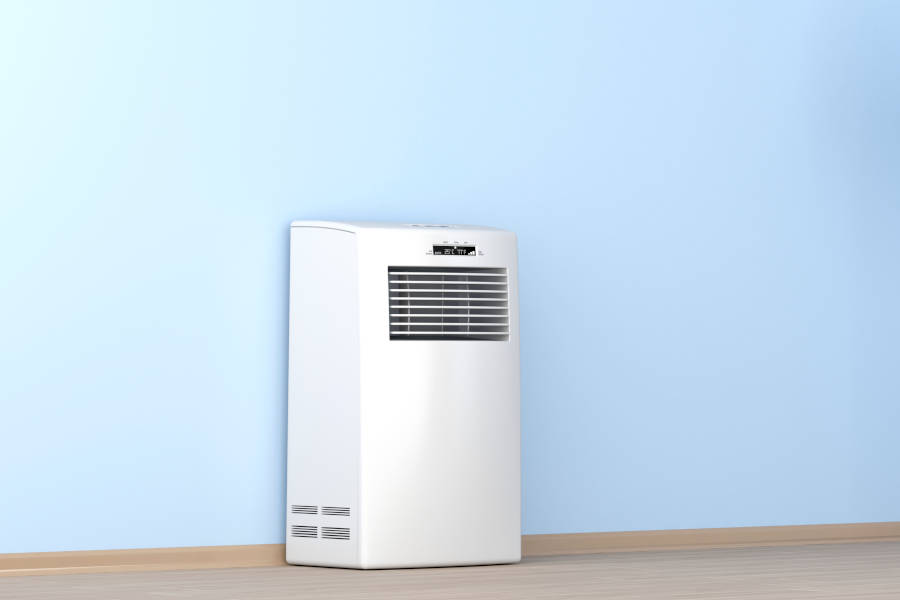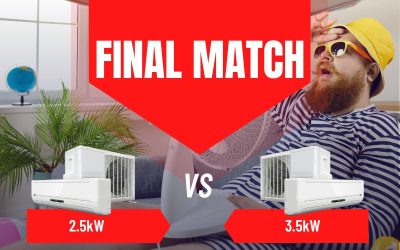A fully functioning air conditioner is a non-negotiable during a hot Aussie summer, especially in a sweltering city like Brisbane. So when your portable air conditioner suddenly stops working correctly, it’s only natural for panic to ensue.
But no need to get too worked up just yet. There’s a solid chance you could fix your portable air-conditioner on your own.
In this post, we’re covering five of the most common reasons a portable AC might malfunction and offering actionable advice on how to rectify each issue.
We’ll also discuss the lifespan of a portable air conditioner and how its running costs stack up against a split system.
Troubleshooting the top 5 issues with portable air conditioners
These are some of the most common causes of a malfunctioning portable air-conditioner, from power issues to flooded reservoirs.
The portable AC won’t turn on
A non-starting portable AC has likely succumbed to a power supply issue.
Start with the obvious. Ensure the power cord is properly plugged into an outlet and the unit and outlet have been switched on. Next, examine the cord for fray damage and try a different outlet.
Should that fail to resolve the issue, you could have a tripped circuit breaker in your home. Find your electrical box and flip the switch off for the relevant room. After a few seconds, flip the switch back on and test the AC again.
If the unit still won’t fire up, but the power in your place is otherwise fine, you can assume the issue lies with the portable air-conditioner. Consult the owner’s manual for advice on how to replace its fuses. If you can’t find any information, call the manufacturer to arrange a repair.
The portable AC stops working randomly
It’s far more likely a portable air conditioner will turn itself off for a reason rather than randomly.
The first potential cause seems obvious but is easy to miss: check whether you’ve got an active timer turned on. These handy features let you program your air conditioner to automatically switch on at pre-determined times, allowing you to return home from work to a nice cool house.
However, it’s possible to set a timer without realising it, perhaps while adjusting the thermostat or accidentally sitting on the remote. If you’re unsure how to check your timer, look in the owner’s manual.
Another possible reason is the room temperature is lower than you think. Once the thermostat detects the pre-determined ambient temperature, it’ll automatically switch the portable air-conditioner off—just like a split cycle system. Try turning the unit off, waiting for the room to heat up, and then turning it back on again.
Of course, a thermostat can malfunction, which could cause it to turn the air-conditioner off at random intervals. In this situation, you’ll need a professional to diagnose and fix the issue.
The AC unit turns on, but no air comes out of the vents
Your portable air-conditioner could have stopped pumping air out of the vents for numerous reasons.
The most common cause is an overflowing condensation tank. Many portable units have a sensor that detects when it’s full of water. To avoid flooding the floor, the AC will refuse to operate until you have emptied the tank. Alternatively, the tank may not be properly positioned, which could confuse the sensor. Empty the condensation tank and ensure it’s correctly aligned to resolve the issue.
A clogged filter is another common culprit. Take the grill off the back and clean the filter with a soft-bristle brush or vacuum cleaner. If it’s super dirty, give it a rinse in running water, then dry it off before putting it back on.
It’s also possible the cooling coils, also known as evaporator coils, have frozen solid. Low temperatures can cause the water surrounding them to condense and potentially freeze, dramatically inhibiting airflow.
Take the back grill off and poke around to find the evaporator coils (the owner’s manual can help). If they appear frozen, switch the AC off for a few hours until it defrosts, then start it back up again.
Finally, an overheating compressor could be the root cause. The compressor needs to vent the heat it generates through your outlet hose. If the hose is clogged, kinked, or too saggy, it won’t facilitate sufficient airflow, which will cause the compressor to overheat.
Check whether the outlet hose is venting correctly and is free from kinks and blockages. Move it further away from the window, as any sagging can reduce airflow. Once you’re done, allow 30 minutes of cool-down time before switching the compressor back on.
Cold air comes out of the vents, but it’s not enough to cool the room
If your working portable air conditioner isn’t cooling down the room, it’s probably not quite powerful enough for the job. In the HVAC world, we use a standard measurement called the British Thermal Unit (BTU) to gauge heating or cooling power.
If your unit doesn’t have sufficient BTUs for the size of your room, it’ll achieve lacklustre results. To find out, first measure the square metre dimensions of your room. Then, compare that to the following chart:
- 18 m² 9 000 BTU
- 25 m² 12 000 BTU
- 36 m² 18 000 BTU
- 50 m² 24 000 BTU
- 60 m² 30 000 BTU
Going slightly over these figures is fine. However, avoid getting a portable AC unit significantly higher than the recommended BTU, as you’ll waste vast sums of cash on your utility bill.
Another possible cause, which is entirely plausible during a Brisbane summer, is that it’s just way too hot outside. Portable air conditioners require an adequately sealed home and a relatively mild ambient temperature to work correctly. The unit may struggle to keep up with demand when the mercury starts to hit the high 30s and 40s.
Sunlight is a contributing factor, so go around the room and close all your blinds. But other than that, the only thing you can do is invest in a superior split system or ducted AC.
What is the lifespan of a portable air conditioner?
The portable AC is the least durable air-conditioner type, with an average life expectancy of just 5-10 years. Compare that to a central split-system air-conditioner, which lasts 20-25 years.
Frequent manoeuvring, low-quality compressors, and cheap materials are responsible for the portable unit’s uninspiring lifespan.
Is a portable air conditioner more expensive to run than a split system?
While the portable air-conditioner is cheaper to purchase outright and doesn’t require installation, the catch is it costs significantly more to run.
According to Origin Energy, a portable air-conditioner can cost up to $201 per year more than a modern split system. Factor that in with its minuscule lifespan, and the “cheap” portable air-conditioner isn’t so cost-effective after all.
Get in touch with Advanced Climate Solutions
Looking for a comprehensive split system or ducted air conditioning solution in Brisbane?
Get in touch with the team at Advanced Climate Solutions today. We work with the best brands in the business and use qualified specialists to conduct all our installation and repair services. Our fair prices and high-quality workmanship have led us to become the leading AC supplier in Brisbane.




